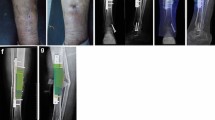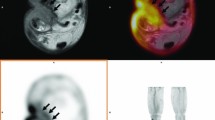Abstract
Objective
In diagnosing osteomyelitis (OM) both MRI and [18 F]FDG PET-CT proved to be accurate modalities. In anticipation of the advent of hybrid PET/MRI scanners we analyzed our patient group to give direction to future imaging strategies in patients with suspected OM.
Materials and methods
In this retrospective study all patients of a tertiary referral center who underwent both an MRI and a PET for the diagnosis of OM were included. The results of those scans were evaluated using patient’s histology, microbiological findings, and clinical/radiological follow-up. Additionally, ROC curve analysis of the SUVmax and the SUVmax ratio on the PET scans was performed. Two imaging strategies were simulated: first MRI followed by PET, or vice versa.
Results
Twenty-seven localizations in 26 patients were included. Both MRI and PET were shown to be accurate in our patients for the qualitative detection of OM. A cut-off value for the SUVmax of 3 gave optimal results (a specificity of 90 % with a sensitivity of 88 %). The SUVmax ratio gave a worse performance. The two simulated imaging strategies showed no difference in the final diagnosis in 20 out of 27 cases. Remarkably, 6 equivocal cases were all correctly diagnosed by the second modality, i.e., PET or MRI.
Conclusion
Both MRI and [18 F]FDG PET were accurate in diagnosing OM in a tertiary referral hospital population. Simulation of imaging strategies showed that a combined sequential strategy was optimal. It seems preferable to use MRI as a primary imaging tool for uncomplicated unifocal cases, whereas in cases with (possible) multifocal disease or a contraindication for MRI, PET is preferred. This combined sequential strategy looks promising, but needs to be confirmed in a larger prospective study.



Similar content being viewed by others
References
Harris JC, Caesar DH, Davison C, Phibbs R, Than MP. How useful are laboratory investigations in the emergency department evaluation of possible osteomyelitis? Emerg Med Australas. 2011;23(3):317–30.
Pineda C, Vargas A, Rodriguez AV. Imaging of osteomyelitis: current concepts. Infect Dis Clin N Am. 2006;20(4):789–825.
Tice AD, Hoaglund PA, Shoultz DA. Outcomes of osteomyelitis among patients treated with outpatient parenteral antimicrobial therapy. Am J Med. 2003;114(9):723–8.
Dong MJ, Zhao K, Liu ZF, Wang GL, Yang SY, Zhou GJ. A meta-analysis of the value of fluorodeoxyglucose-PET/PET-CT in the evaluation of fever of unknown origin. Eur J Radiol. 2011;80(3):834–44.
Glaudemans AW, Signore A. FDG-PET/CT in infections: the imaging method of choice? Eur J Nucl Med Mol Imaging. 2010;37(10):1986–91.
Wang GL, Zhao K, Liu ZF, Dong MJ, Yang SY. A meta-analysis of fluorodeoxyglucose-positron emission tomography versus scintigraphy in the evaluation of suspected osteomyelitis. Nucl Med Commun. 2011;32(12):1134–42.
Ma LD, Frassica FJ, Bluemke DA, Fishman EK. CT and MRI evaluation of musculoskeletal infection. Crit Rev Diagn Imaging. 1997;38(6):535–68.
Schwegler B, Stumpe KD, Weishaupt D, Strobel K, Spinas GA, von Schulthess GK, et al. Unsuspected osteomyelitis is frequent in persistent diabetic foot ulcer and better diagnosed by MRI than by 18 F-FDG PET or 99mTc-MOAB. J Intern Med. 2008;263(1):99–106.
Gold RH, Hawkins RA, Katz RD. Bacterial osteomyelitis: findings on plain radiography, CT, MR, and scintigraphy. AJR Am J Roentgenol. 1991;157(2):365–70.
Shah LM, Salzman KL. Imaging of spinal metastatic disease. Int J Surg Oncol. 2011;2011:769753.
Stumpe KD, Zanetti M, Weishaupt D, Hodler J, Boos N, Von Schulthess GK. FDG positron emission tomography for differentiation of degenerative and infectious endplate abnormalities in the lumbar spine detected on MR imaging. AJR Am J Roentgenol. 2002;179(5):1151–7.
Boellaard R, Oyen WJ, Hoekstra CJ, Hoekstra OS, Visser EP, Willemsen AT, et al. The Netherlands protocol for standardisation and quantification of FDG whole body PET studies in multi-centre trials. Eur J Nucl Med Mol Imaging. 2008;35(12):2320–33.
Nawaz A, Torigian DA, Siegelman ES, Basu S, Chryssikos T, Alavi A. Diagnostic performance of FDG-PET, MRI, and plain film radiography (PFR) for the diagnosis of osteomyelitis in the diabetic foot. Mol Imaging Biol. 2010;12(3):335–42.
Hanna SL, Fletcher BD, Fairclough DL, Jenkins 3rd JH, Le AH. Magnetic resonance imaging of disseminated bone marrow disease in patients treated for malignancy. Skeletal Radiol. 1991;20(2):79–84.
Glaudemans AW, Quintero AM, Signore A. PET/MRI in infectious and inflammatory diseases: will it be a useful improvement? Eur J Nucl Med Mol Imaging. 2012;39(5):745–9.
Conflict of interest
No conflict of interest.
Author information
Authors and Affiliations
Corresponding author
Rights and permissions
About this article
Cite this article
Demirev, A., Weijers, R., Geurts, J. et al. Comparison of [18 F]FDG PET/CT and MRI in the diagnosis of active osteomyelitis. Skeletal Radiol 43, 665–672 (2014). https://doi.org/10.1007/s00256-014-1844-3
Received:
Revised:
Accepted:
Published:
Issue Date:
DOI: https://doi.org/10.1007/s00256-014-1844-3




